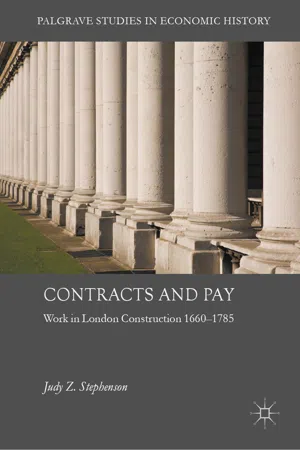Throughout history, construction workers have not only built many of the landmarks of modern day London but, unknowingly, given us the building blocks for the methods most widely used to evaluate the economic performance of the past. Economic historians have a long been interested in the pay of construction workers. Just as masons , carpenters , and plumbers proliferate in the account books of old institutions and among wage regulations and statutes of boroughs and sessions across England, building workers and their labourers appear regularly in all discussions of work and wages, in urban and rural history. From the end of the nineteenth century, economic and social historians began to use builder’s recorded ‘day wages’ to represent an average non-agricultural worker’s pay in studies of long run wage trends . By converting this ‘average wage’ into a long-run data series, they created influential estimates of living standards , ‘welfare ratios’, GDP and national output , economic growth rates, human capital or skill levels, and associated labour supply and demand .1
Our knowledge about the trends and comparative features of early modern European economies may rely on builder’s wages, but those wages were gathered without much reference to how the construction industry actually developed throughout the early modern period.2 This book will show, with hard evidence, that the empirical base for our understanding of early modern wage earning and the organisation of the construction industry in England should be revised. It argues that builders’ wages are a poor proxy or data set for estimating living standards and real wages in the very long run, but that there is much to be learned from a closer look at the construction industry in this period. It offers a new narrative for economic historians to understand and interpret the construction industry in early modern England that draws on established architectural history and on a broadly conceived transaction cost tradition in economics and business history. Whilst firmly rooted in broad economic history narratives, it brings new case studies from new sources to light which will be of interest to construction, business and social historians. For some, this new narrative will appear unusual. It does not talk much about guilds, corporations, customs , apprentices , and trades . The unit of analysis is, for the most part, the contract , the ‘firm ’, and the worker within it. The analysis challenges some established narratives, ideologies, and practices, but the method is wholly rooted in archival evidence.
The Creation of Statistical Wage Series
How did builder’s pay come to be the measure of the historical ‘average’ wage? One of the primary reasons is the lack of any other sources. Students of early modern economic and social history are frequently told about the scarcity of wage records. The records of most organisations before the mid nineteenth century do not contain wage books. They are heavy with bills, vouchers, acquittances, and payments. Any references to wage payments tend to be irregular and fragmentary. Court and sessions records , the sources of so much rich economic and social information, often refer to the payment or non-payment of ‘wages’, but rarely tell us how much those wages were.
In England, a seminal contribution to historical wages and prices was made by J.E. Thorold Rogers in the late nineteenth century.3 Rogers’ aim was a definitive history, or a full account of prices and wages. The introduction to the final volume highlights how huge an undertaking this was. The task may have been long and arduous, but the methodology was simple. Rogers sourced the recorded prices of goods, commodities, materials , produce, and labour across the United Kingdom over a span of six centuries. Identifying institutions that were likely to have very long-run records—such as Oxford and Cambridge Colleges, Westminster Abbey , the Inns of Court etc.—he noted the units and prices at each location at various dates in the long run. The results were displayed in list form, categorized by type of good, in seven volumes, with the last volume made up of two parts.
Old organizations have both old buildings that need maintenance and an occasional requirement for new accommodation, and so tend to have a lot of building accounts. Rogers’ data set had almost continuous records of carpenters , masons , bricklayers, and labourers , and many for plumbers and glaziers too. Rogers’ records are acknowledged, rightly, as completely accurate, but it is easy for the modern researcher to not appreciate his life’s work as much as they might. The information given is listed by year, by type of good, and then place, but the observations are given in note form with idiosyncratic abbreviations for the quantities and other information. Anyone who wants to use the information must re-transcribe the data, and then convert the measures or units into standard form before comparing or utilizing the data further. As no names or other account information are usually given, it cannot be ascertained whether long-term contractual considerations affected prices. For instance, when bread or coal was purchased by Westminster Abbey at the same price per loaf or cauldron in two separate years, it is not clear if it was sold to them by one or various vendors.4 Regarding wages, Rogers’ unequivocal finding was that from 1563 to 1824 the authorities and employers conspired to ‘cheat the English workman of his wages’, and ‘were engaged in grinding the English workman down to the lowest pittance’.5
At the end of the nineteenth century, the role of wages in understanding the economy more broadly continued to be developed in a statistical , rather than historical or theoretical, manner. Arthur Bowley is considered the father of modern statistics by many. We may also consider him father of the modern historical wage series. Bowl...
